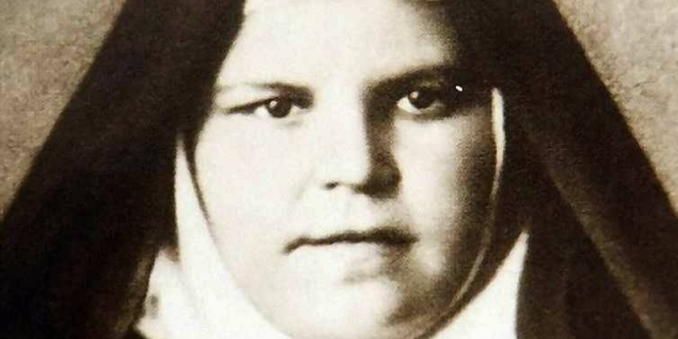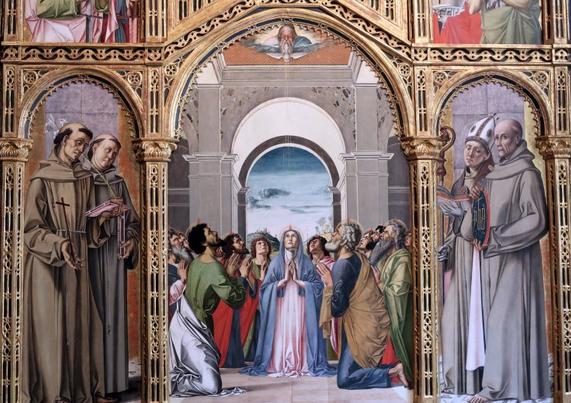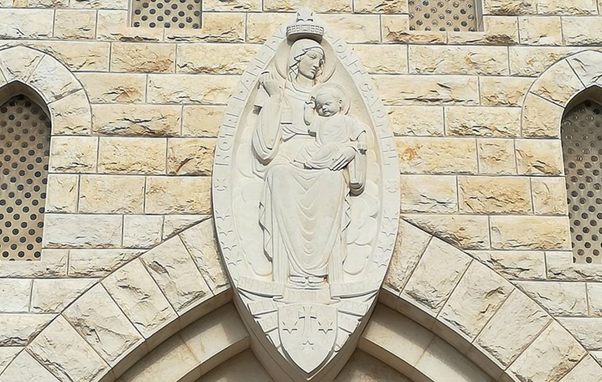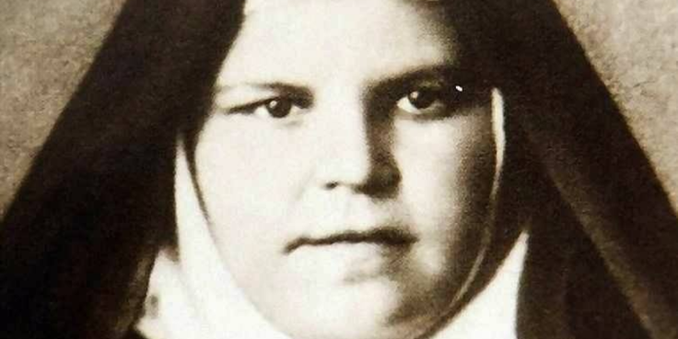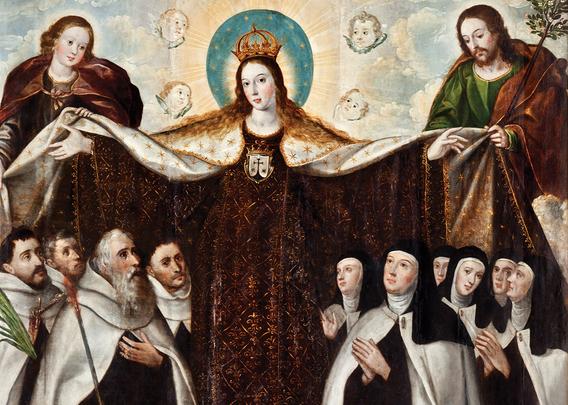Quote of the day, 13 November: St. John Paul II
“Listen, daughter”… (Psalm 45:11).
1. Today the Church applies these words of the Psalm to Sister Mary of Jesus Crucified, a Discalced Carmelite nun, born in the land that saw the unfolding of the life of Jesus of Nazareth; a land situated in a region that, even today, remains at the center of grave concerns and painful tensions.
“Listen, daughter.” Behold, Sister Mary’s journey toward the divine Bridegroom is now profoundly inscribed in the memory of the People of God. Today, the Church crowns her with the act of beatification. This act bears witness to the unique spiritual “beauty” of this daughter of the Holy Land—a “beauty” that has matured in the glow of the mystery of Redemption: in the rays of the birth and teaching, the cross and resurrection of Jesus Christ.
The liturgy says to the new Blessed: “He is your Lord: bow down to him” (Ps 45:11–12).
And at the same time, with the words of the same Psalm, the liturgy manifests the joy for the elevation to the altar of the humble Servant of God.
“The princess is decked in her chamber with gold-woven robes…” (Ps 45:13–14): the golden fabric of faith, hope, and love; of the theological and moral virtues that she practiced to a heroic degree as a daughter of Carmel.
2. In this Year that the Church experiences as an extraordinary Jubilee of the Redemption, many times we have gathered around figures who have reached the glory of the altar. It is a special sign of the inexhaustible power of the Redemption, which works in the souls of the Servants of God, allowing them to continue tenaciously on the path of the vocation to holiness.
This vocation has its eternal beginning in the salvific plan of the Most Holy Trinity, of which the second reading of the Mass speaks: “For those whom he foreknew he also predestined to be conformed to the image of his Son, in order that he might be the firstborn within a large family. And those whom he predestined he also called; and those whom he called he also justified; and those whom he justified he also glorified” (Rom 8:29–30).
In this grandiose Pauline vision, we penetrate, so to speak, into the very depths of divine thought, grasping in some way the “logic” of the plan of salvation, in the progression of the mysterious actions that lead to its full implementation. Thus, the vocation to holiness is God’s eternal plan with regard to man: with regard, today, to our sister Mary of Jesus Crucified.
True wisdom and intelligence presuppose “littleness,” understood as docility to the Holy Spirit. It is only through this littleness that one can, in the Son, for the Son, and with the Son, come to know the mysteries of the Father. These remain hidden from the wise and learned of this world, who are blinded by foolishness and pride (Cf. 1 Cor 1:18–21).
3. The vocation to holiness is carried out by those “infants” of the Gospel who accept divine Revelation with all their hearts. Thanks to this, they “know the Son,” and thanks to the Son, they “know the Father.”
Such knowledge is, in fact, at the same time, the acceptance of the vocation: “Come to me… Take my yoke upon you, and learn from me…” (Mt 11:28–29).
And so we go to Christ just as Sister Mary of Jesus Crucified came to him, that is, taking his yoke upon ourselves, learning from him, because he is meek and humble of heart, and finding solace for our souls (Cf. Mt 11:28–29).
4. And all this is the work of love. Holiness, first of all, is based on love. It is its mature fruit. And in today’s liturgy, in a particular way, love is exalted:
- “love, as strong as death”;
- “the love that floods cannot drown”;
- “love, in exchange for which one must give all the wealth of one’s house” (Cf. Song 8:6–7).
Thus speaks the author of the Song of Songs. And Saint Paul, in his Letter to the Romans, teaches that “all things work together for good for those who love God” (Rom 8:28). Precisely this cooperation traces the path of holiness, one might say, day by day throughout one’s life. On this path, holiness is realized as the eternal vocation of those “who have been called according to God’s plan” (Cf. Rom 8:28).
5. The readings of today’s Liturgy are a splendid commentary on the life of Sister Mary, who was born near Nazareth and died in the Carmel of Bethlehem at the age of 33. Her love for Christ was as strong as death; the most painful trials did not extinguish it, but on the contrary, purified and strengthened it. She gave everything for this love.
The entire life of the little Arab girl, filled with extraordinary mystical gifts, was, in the light of the Holy Spirit, the conscious and irrevocable response to a vocation of holiness, that is, to that eternal plan of salvation, of which St. Paul speaks, which divine mercy has established for each of us.
Her whole life is the fruit of that supreme evangelical “wisdom” with which God delights in enriching the humble and the poor, confounding the powerful. Endowed with great clarity of mind, a fervent natural intelligence, and that poetic imagination characteristic of the Semitic peoples, little Mary did not have the opportunity to gain access to advanced studies, but this did not prevent her, thanks to her eminent virtue, from being filled with that “knowledge” that has the greatest value, and to give us the knowledge that Christ died on the cross: knowledge of the Trinitarian Mystery, such an important perspective in that Eastern Christian spirituality in which the little Arab girl had been educated.
6. As we read in the Canonical Decree of Beatification, “the humble servant of Christ, Mary of Jesus Crucified, belonging by lineage, rite, vocation, and wanderings to the peoples of the East and being in some way a representative of them, is like a gift from the peoples of the East to the universal Church. These peoples, suffering in miserable conditions of struggle and bloodshed, especially now, turn with great trust to her fraternal intercession, in the hope that, thanks also to the Servant of God’s prayers, peace and harmony finally will be restored in those lands where ‘the Word became flesh’ (Jn 1:14) since he himself is our peace.”
Blessed Mary was born in Galilee. That is why our prayerful thought wants to go today in a special way to the Land where Jesus taught love and died so that humanity might have reconciliation. “That Land,” as I recalled on another occasion, “for decades has seen two peoples opposed in a hitherto irreducible antagonism. Each of them has a history, a tradition, a story of their own, which seem to make it difficult to reach an agreement” (John Paul II, Allocutio occasione oblata orationis dominicae Angelus Domini habita, 5, domenica 4 aprile 1982: Insegnamenti di Giovanni Paolo II, V/1 [1982] 1110).
Today more than ever before, the threats looming over us urge us to make love and brotherhood the fundamental law of social and international relations, in a spirit of reconciliation and forgiveness, taking inspiration from the way of life of which Blessed Mary of Jesus Crucified is an example not only for her people but for the whole world. May this new way of life give us peace based not on terror, but on mutual trust.
7. We rejoice today at the altar of the Confession of St. Peter for the beatification of Sister Mary. We inscribe this joy of the Church in the record of the Jubilee Year of Redemption. Together with Christ, we praise the Father, who revealed to the soul of Sister Mary of Jesus Crucified the mystery of truth and love, making her a sharer in the glory of his Kingdom.
With the Psalmist, let us pray to the new Blessed that the Lord may grant peace to her land: “Pray for the peace of Jerusalem: ‘May they prosper who love you. Peace be within your walls, and security within your towers.’ For the sake of my relatives and friends I will say, ‘Peace be within you.’ For the sake of the house of the Lord our God, I will seek your good” (Ps 122:6–9).
Saint John Paul II
Homily, Beatification of St. Mary of Jesus Crucified
13 November 1983, St. Peter’s Basilica
Translation from the Italian text is the blogger’s own work product and may not be reproduced without permission.
Featured image: Saint Mary of Jesus Crucified (Mariam Baouardy). Image credit: Discalced Carmelites
#beatification #DiscalcedCarmelite #homily #mariamBaouardy #nun #StJohnPaulII #StMaryOfJesusCrucified

